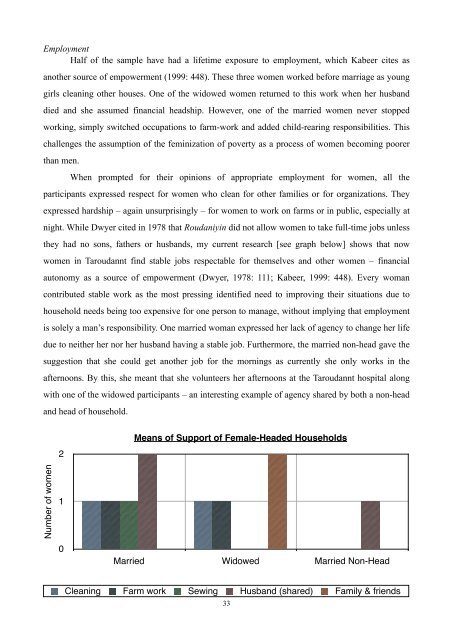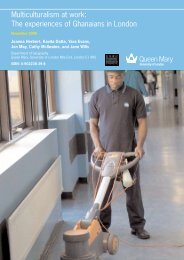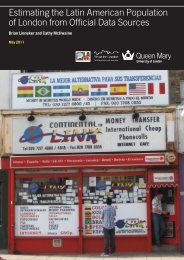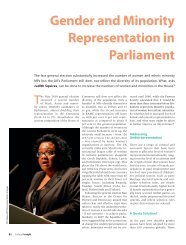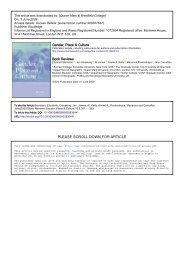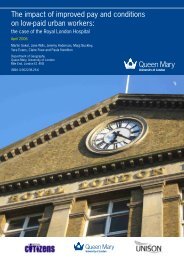Women's Empowerment and the Feminization of Poverty among
Women's Empowerment and the Feminization of Poverty among
Women's Empowerment and the Feminization of Poverty among
- No tags were found...
You also want an ePaper? Increase the reach of your titles
YUMPU automatically turns print PDFs into web optimized ePapers that Google loves.
EmploymentHalf <strong>of</strong> <strong>the</strong> sample have had a lifetime exposure to employment, which Kabeer cites asano<strong>the</strong>r source <strong>of</strong> empowerment (1999: 448). These three women worked before marriage as younggirls cleaning o<strong>the</strong>r houses. One <strong>of</strong> <strong>the</strong> widowed women returned to this work when her husb<strong>and</strong>died <strong>and</strong> she assumed financial headship. However, one <strong>of</strong> <strong>the</strong> married women never stoppedworking, simply switched occupations to farm-work <strong>and</strong> added child-rearing responsibilities. Thischallenges <strong>the</strong> assumption <strong>of</strong> <strong>the</strong> feminization <strong>of</strong> poverty as a process <strong>of</strong> women becoming poorerthan men.When prompted for <strong>the</strong>ir opinions <strong>of</strong> appropriate employment for women, all <strong>the</strong>participants expressed respect for women who clean for o<strong>the</strong>r families or for organizations. Theyexpressed hardship – again unsurprisingly – for women to work on farms or in public, especially atnight. While Dwyer cited in 1978 that Roudaniyin did not allow women to take full-time jobs unless<strong>the</strong>y had no sons, fa<strong>the</strong>rs or husb<strong>and</strong>s, my current research [see graph below] shows that nowwomen in Taroudannt find stable jobs respectable for <strong>the</strong>mselves <strong>and</strong> o<strong>the</strong>r women – financialautonomy as a source <strong>of</strong> empowerment (Dwyer, 1978: 111; Kabeer, 1999: 448). Every womancontributed stable work as <strong>the</strong> most pressing identified need to improving <strong>the</strong>ir situations due tohousehold needs being too expensive for one person to manage, without implying that employmentis solely a man’s responsibility. One married woman expressed her lack <strong>of</strong> agency to change her lifedue to nei<strong>the</strong>r her nor her husb<strong>and</strong> having a stable job. Fur<strong>the</strong>rmore, <strong>the</strong> married non-head gave <strong>the</strong>suggestion that she could get ano<strong>the</strong>r job for <strong>the</strong> mornings as currently she only works in <strong>the</strong>afternoons. By this, she meant that she volunteers her afternoons at <strong>the</strong> Taroudannt hospital alongwith one <strong>of</strong> <strong>the</strong> widowed participants – an interesting example <strong>of</strong> agency shared by both a non-head<strong>and</strong> head <strong>of</strong> household.2Means <strong>of</strong> Support <strong>of</strong> Female-Headed HouseholdsNumber <strong>of</strong> women10Married Widowed Married Non-HeadCleaning Farm work Sewing Husb<strong>and</strong> (shared) Family & friends33


